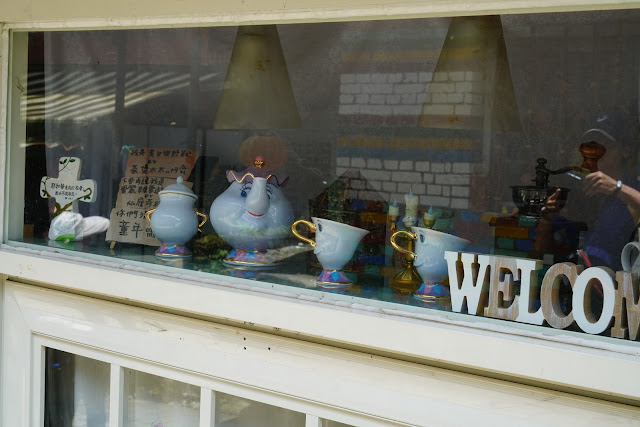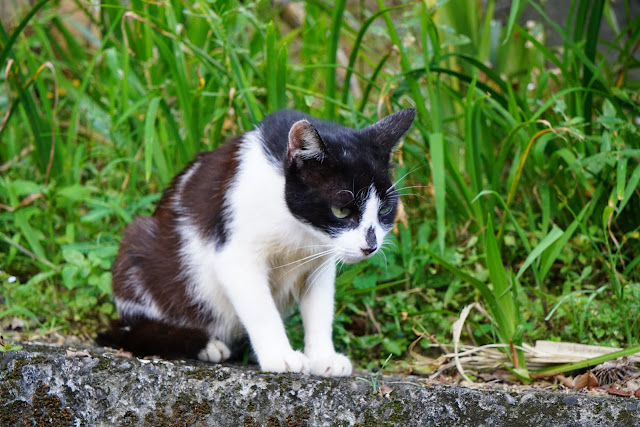Pingxi District ( 平溪區) is where the Keelung River begins( in fact it starts Jingtong) In early 20th century, the Pingxi town itself was an important coal mining centre. The area was first settled in the 1870's when the local population started growing a plant called in Chinese 大菁(大青)or 細葉臭牡丹、臭腥公、山尾花、淡婆婆、鴨公青、山漆, used in the preparation of blue dyes but with the growing use of artificial dyes that declined and the population switched to growing Ooloong tea (大葉烏龍、青心烏龍) as well as 青心大冇 and 硬枝紅心. In 1920's the Poon and Ngan clans began mining coal in the area. At its height, it had more than 20 such mines. But in the 1970s, with the import of petroleum, coal mining declined and its days of glory are over. Now the population has dwindled to only less than 5,000. The Pingxi District is however very rich in water resources. It's got more than 200 rainy days per year with average rainfall of 3,500 mm each year. In 1912, it had a record 8,500
mm and in 1986, 6224 mm. It's also known for its 36 waterfalls.

My first view of Pingxi,a rural district in eastern New Taipei City in northern Taiwan, the average age of whose population is more than 50 compared to the national average of about 38 and is the highest in the whole of Taiwan.

Up on the hills opposite to the road is the Pingxi Railway Station, the starting point of the Pingxi line which terminates in Jing Tong which I visited earlier that morning.

This is part of the Keelung River which starts in Jing Tong.

This is the continuation of the same river on the other side of the bridge from which this photo is taken.The way the stones used to protect the banks are laid out look most Japanese.

Beautiful clouds drifting over Pingxi

The color and pattern of this curtain over the door also looks very Japanese to me.

Why a shop with this name? I learned from our guide-driver that after the Chinese New Year festival ends every year , a Sky Lantern Festival will be held here, with participants from all over the world, including Mexico, Japan and mainland China. The people will have their wishes
written on the sky lanterns and then release them to the skies .The
custom of flying sky lanterns developed because in the early days, the
place was infested with bandits. Then some clever guy in the villages hit upon the briilliant idea of flying this ancient invention in the sky as a method
of informing those working in the fields it was safe to return home.

The shop sells all kinds of paraphernalia connected to the traditional sky lanterns.

2017 is the 130th anniversary of the first railways in Taiwan. Hence, the sale of medalions to commemorate the occasion.

The single rail Pingxi line

A pair of young lovers having fun whilst waiting for the train, the contemporary way: the boy and the girl each with an I-phone, though physically close.

The ubiquitous well-wishing bamboo tubes hung at one side of the rail platform.

This is how I learned about the Railway Festival.

There's a free chop with which those interested may mark in their personal paper pad the name of the Pingxi Station as a memento of their visit of the station.

But instead of being tempted by the chop, I couldn't resist making a record of the clouds there with my camera.

I started walking up the Pingxi Old Street which started with a nicely decorated terraced restaurant above and a souvenir shop below.

Fun pottery on display.

It's obvious whether the owner of the shop is male or female.

Another house close by with very colorful painted bricks on the lower portion of its wall and decorated with a huge wooden railroad sleeper.

The cartoon style dolls outside its windows

Another shop selling sky lanterns.

A Hakka floral print workshop for waterproof aprons, child bearing back-bands, head cloths, protective sleeves, bed covers, clothes etc.

Various posters encouraging offering neighborly assistance to others in different commonly met situations, on the walls of a community centre. Looks fairly amateurish.

The slogans: You and I loving to pour out a little of our hearts, how warm t'is to have community welfare!

A humorous addition posted on top of a "No Through Road" traffic sign. It says, mimicking the common Protestant Slogan " Believe in Jesus, You'll have Eternal Life": "Believe in Tso Cho, You'll have Eternal Life"!

Mountain Spring Bean Curd Pudding of Pingxi!

Straw fans, hats, fans and sandals in no particular order.

Very colorful ladies garments and hats for this town of relatively old people!

Accidental shadows.

The municipal notice board proudly displays the achievements of its students in regional competitions in athletics, basketball, calligraphy and music and the quality of its caves in its geological parks.

More notices of its wins in language competition, changes in the opening hours of its clinics and various other community activities.

An unusual advertising sign in cloth boasting that it's be as if one never visited Pingxi if one never tasted its ancient food preparation recipes.!

A huge wall painting advertising the Pingxi Sky Lantern Festival but the children seem more interested in the vertical poster board.

The popular "iron eggs"!

Pig blood cake

Spiced fried bean curd slices

Braised and seasoned chicken hearts

Believe it or not. Red Indian dream catchers in Pingxi !

A proud peanut and sesame chewy candy master in front of his work

His products in two flavors

Pingxi is famous for its tea. The 6-Door Cafe and Tea House selling both.

I like the way the owner lines up his shop front with potted plants

A private culture club


Another shop selling colorful ladies scarfs, fashion and handbags

Huge fortune-seeking sky lanterns

A modernised sky lantern lamp shade made by a former tailor

Two sky lantern shaped lamp shade with more traditional patterns

The staircase wall of the old Pingxi post office

Antique post box

It boasts the oldest post box in the whole of Taiwan!

A pillar saying that it was put up in 1941 when it was still under Japanese rule

A notice explaining the historical origin of the cast iron post box in Pingxip expresly designed to fit the height of that of an ordinary adult

Houses built amidst dense vegetation on the opposite bank

Another view of the old Pingxi Post Office

An arched bridge across the steep ravine

The limestone terrace below the bridge

Pingxi stream

The seat of the Pingxi town office

A fuller view of the town office

a reflected sky.

The clouds are thick

A Taoist temple

Some roadside flowers

The cave of the 8 Taoist divinities at the Koon Yin Rock.To Chinese, Buddhism and Taoism can co-exist quite happily.

A laughing buddha

The Kuanyin Wishing Pool inside the cave

I was told that during the war, this served as an air raid shelter. The place has dozens of such rooms linked to each other in a maze of underground tunnel network.

The distant hills

A plague in praise of public welfare erected in 1952 to commemorate the building of the the 12 mile railway linking Pinxi and Jintong by the Poon families o serve the coal mines there, with an annual production of some 20 tons of coal.

The statue of General Kuan Yunchang (160/2-220)

The Koon Yin or Queen of Heaven

Various Taoist deities

a very lively dragon decorating the right temple pillar

The dragon decorating the other pillar

A Chinese unicorn


The flower offering fairy

The fruit offering fairy

The clouds are gathering overhead

After visiting the Taoist temple, we were taken to the hills nearby to take a look at the lover's bridge and the Tocsin Bell Tower

The Tocsin Bell Tower was pretty run down already

The Lover's Bridge had some loosened plank and was closed for repair

We took a hillside path down hill and saw what is called "A-Vegetable". Never knew it could be so tall !

A pair of unripe pomelo fruit

A patch for melon cultivation.

The road sign for the Pingxi Old Street

There, high up and tiny as a mere dot against the thick black cloud, is a sky lantern.

What is this zebra doing here at the side of the path?

finally down to railroad level

Just as we arrived, "hark", a diesel train is arriving!

A suspicious cat by the side of the path.

Some purple orchid at the side of the path

Another unknown species of flower close by

We got these in Hong Kong too

The Taiwanese are really fond of bean curds. They have hundreds of way of making and preparing it

They are also fond of grass jelly as a snack

So you find many stalls selling it

Some of the shops have got a more contemporary look

Another bean curd stall selling fermented fried bean curd slices

Time for lunch. Our driver-guide took us to this local restaurant

As he is a Buddhist, we had another all vegetable meal.

This dish of orange daylily flower(金針花) is delicious

So is this dish of fresh bamboo tips. Our driver-guide told us that the tips must be harvested before daybreak before they emerge on to the ground. Otherwise, their texture would turn much rougher. It's the first time in my life that that I ate such fresh bamboo tips. I never knew bamboo tips could taste so good !

Time we finished our lunch

We had this mixed vegetable soup. Also excellent.

The place may look unappetizing but its food is excellent. No wonder it's always packed with customers.

Another pot was boiling as I paid for the meal. Looks and smells very tempting.

The menu. This restaurant reminds me once again that appearance may often be deceptive.
沒有留言:
張貼留言